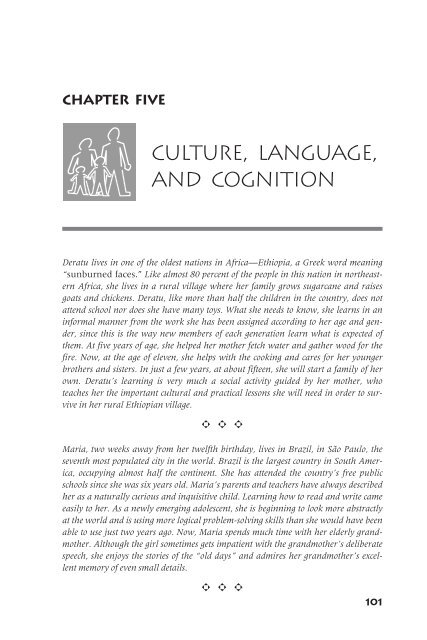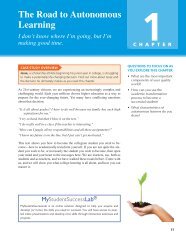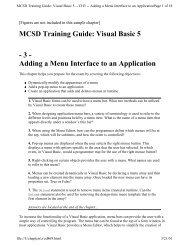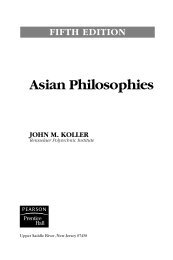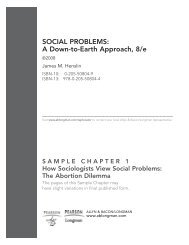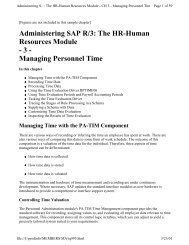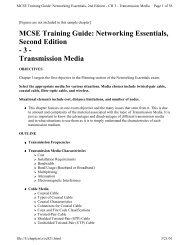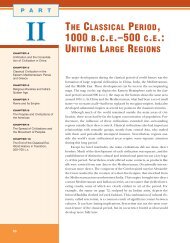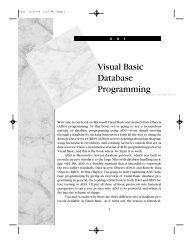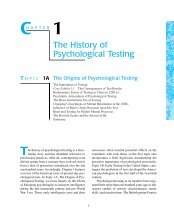CULTURE, language, AND COGNITION
CULTURE, language, AND COGNITION
CULTURE, language, AND COGNITION
Create successful ePaper yourself
Turn your PDF publications into a flip-book with our unique Google optimized e-Paper software.
GA305c05.qxd 4/30/2004 11:26 AM Page 101<br />
Chapter five<br />
<strong>CULTURE</strong>, <strong>language</strong>,<br />
<strong>AND</strong> <strong>COGNITION</strong><br />
Deratu lives in one of the oldest nations in Africa—Ethiopia, a Greek word meaning<br />
“sunburned faces.” Like almost 80 percent of the people in this nation in northeastern<br />
Africa, she lives in a rural village where her family grows sugarcane and raises<br />
goats and chickens. Deratu, like more than half the children in the country, does not<br />
attend school nor does she have many toys. What she needs to know, she learns in an<br />
informal manner from the work she has been assigned according to her age and gender,<br />
since this is the way new members of each generation learn what is expected of<br />
them. At five years of age, she helped her mother fetch water and gather wood for the<br />
fire. Now, at the age of eleven, she helps with the cooking and cares for her younger<br />
brothers and sisters. In just a few years, at about fifteen, she will start a family of her<br />
own. Deratu’s learning is very much a social activity guided by her mother, who<br />
teaches her the important cultural and practical lessons she will need in order to survive<br />
in her rural Ethiopian village.<br />
���<br />
Maria, two weeks away from her twelfth birthday, lives in Brazil, in São Paulo, the<br />
seventh most populated city in the world. Brazil is the largest country in South America,<br />
occupying almost half the continent. She has attended the country’s free public<br />
schools since she was six years old. Maria’s parents and teachers have always described<br />
her as a naturally curious and inquisitive child. Learning how to read and write came<br />
easily to her. As a newly emerging adolescent, she is beginning to look more abstractly<br />
at the world and is using more logical problem-solving skills than she would have been<br />
able to use just two years ago. Now, Maria spends much time with her elderly grandmother.<br />
Although the girl sometimes gets impatient with the grandmother’s deliberate<br />
speech, she enjoys the stories of the “old days” and admires her grandmother’s excellent<br />
memory of even small details.<br />
���<br />
101
GA305c05.qxd 4/30/2004 11:26 AM Page 102<br />
102 culture, Language, and cognition<br />
Deratu and Maria live worlds apart physically as well as psychologically. In<br />
this chapter, we look at culture, cognition, <strong>language</strong> and their effects on development.<br />
We consider two opposing theoretical viewpoints and some of<br />
the cross-cultural evidence that supports or refutes these views. As you<br />
progress through this chapter, you will be better able to understand and explain<br />
the cognitive and linguistic behavior of these two young women using<br />
key concepts from these theories.<br />
First, let us explain what we mean when we use the terms <strong>language</strong> and<br />
cognition. Cognition can be thought of as the act or process of obtaining knowledge,<br />
including perceiving, recognizing, reasoning, and judging (Gander & Gardiner,<br />
1981). Cognition involves thinking, knowing, remembering, categorizing,<br />
and problem solving. Language refers to a system of symbols that is used to communicate<br />
information and knowledge. How does thinking affect <strong>language</strong>? How<br />
does <strong>language</strong> affect thinking? How do they influence each other? Later in<br />
this chapter, we discuss the links between cognition and <strong>language</strong> as they<br />
occur throughout life. Two of the major theoretical frameworks discussed in<br />
Chapter 2 will guide us in this discussion: Piaget’s cognitive developmental<br />
theory, and Vygotsky’s concept of the “zone of proximal development.”<br />
�� THE LANGUAGE–<strong>COGNITION</strong>–<strong>CULTURE</strong> LINK<br />
One of the early debates linking culture, <strong>language</strong>, and cognition surrounds<br />
the question “Do people who speak different <strong>language</strong>s think about and experience<br />
the world differently?” And if so, are these differences in thinking<br />
due to the structural and lexical (<strong>language</strong> or vocabulary) differences in the<br />
<strong>language</strong>s spoken? Linguists Benjamin Whorf and Edward Sapir are the original<br />
proponents of this line of thought, which is known as the “linguistic relativity<br />
hypothesis.” Elgin (2000) provides an example by comparing the sentence<br />
“I was riding a horse” in English and Navajo. She asserts that the most<br />
likely translation in Navajo would result in “The horse and I were moving<br />
about.” It is easy to see that these two sentences describe the relationship between<br />
horse and rider rather differently. The English version portrays the<br />
rider as the active subject of the action and the horse as the object that endures<br />
being ridden. In Navajo, the act of riding is a joint endeavor without<br />
expressed subject–object relation. A Whorfian would conclude that Navajo<br />
speakers perceive and experience relationship with animals (horses, in this<br />
case) differently than English speakers. If people’s thinking really is relative<br />
to their <strong>language</strong>, perhaps we could explain cultural differences in cognition<br />
by looking at the differences in the <strong>language</strong>s spoken in different cultures.<br />
Unfortunately, research results on the linguistic relativity hypothesis are not<br />
that clear-cut. A few supporting findings exist, but there are seemingly just as<br />
many findings that contradict Sapir’s and Whorf’s ideas.<br />
Researchers have come to agree on a less absolute version of the linguistic<br />
relativity hypothesis. They believe now that thinking is not entirely
GA305c05.qxd 4/30/2004 11:26 AM Page 103<br />
the Language–Cognition–culture link 103<br />
determined by the <strong>language</strong> we speak. Rather, how we talk about people, objects,<br />
or events may make us pay more or less attention to certain aspects of<br />
these events, people, or objects. In different <strong>language</strong>s, we find different linguistic<br />
elements that make it easier to communicate about certain events or<br />
objects. For example, English has a progressive form that allows English<br />
speakers to distinguish between ongoing events and events that have concluded<br />
(“I worked all afternoon” versus “I have been working all afternoon”).<br />
Some <strong>language</strong>s (e.g., German and Hebrew) do not have a progressive form.<br />
Speakers of these <strong>language</strong>s are still able to communicate about the temporal<br />
sequence and duration of events, but they have to make a greater effort to do<br />
so. A Whorfian may argue that distinguishing between the duration of events<br />
may not be as important in German- and Hebrew-speaking cultures but is<br />
more important in English-speaking cultures. In other words, if something is<br />
encoded in a culture’s <strong>language</strong>, it must be important. This milder form of the<br />
linguistic relativity hypothesis led many institutions in the United States, in<br />
recent years, to establish “politically correct” <strong>language</strong>. Many view this as<br />
a well-intended effort to change cultural meaning by changing <strong>language</strong>;<br />
others disagree.<br />
What is Vygotsky’s position on these issues? He claimed that cultural<br />
influence, mental processes, and <strong>language</strong> are dynamic processes that occur<br />
simultaneously. This means that constant social interaction with those<br />
around us helps shape the quality of mental abilities and <strong>language</strong> at various<br />
ages. With this theoretical perspective in mind, Vygotsky coined the expression,<br />
“talking to learn.” By this he meant that as children verbally interact<br />
with others, they internalize <strong>language</strong> and use it to organize their thoughts<br />
(Vygotsky, 1978).<br />
Other researchers go even further and suggest that as parents interact<br />
with their children, the children learn <strong>language</strong> and become socialized into a<br />
particular set of cultural values and beliefs (Greenfield & Cocking, 1994; Budwig,<br />
Wertsch, & Uzgiris, 2000). For example, in her extensive studies of <strong>language</strong><br />
acquisition in a Samoan village, Ochs (1988) showed the presence of<br />
two major ways of speaking the <strong>language</strong>: “good speech” and “bad speech.”<br />
The latter contains fewer consonants and is mainly spoken in informal contexts.<br />
Good speech is used when speaking to strangers or in formal settings<br />
such as schools, church services, and when talking to a person of high status.<br />
Along with learning both “good speech” and “bad speech,” Samoan children<br />
learn about the social contexts in which using each “<strong>language</strong>” is appropriate.<br />
An interesting ongoing debate in the United States surrounds what used to<br />
be called “Black Vernacular English” or “Ebonics.” Ebonics is spoken almost<br />
exclusively among African-Americans and is learned in informal contexts<br />
rather than in formal schooling (for an overview, see Fasold, 1999).<br />
Consequently, as children pass through Vygotsky’s zone of proximal<br />
development in their <strong>language</strong> learning, they also acquire specific cognitive<br />
skills and they are becoming enculturated into a way of life. An effective<br />
method for achieving this is scaffolding, which refers to the temporary sup
GA305c05.qxd 4/30/2004 11:26 AM Page 104<br />
104 culture, Language, and cognition<br />
port or guidance provided to a child by parents, older siblings, peers, or other adults in<br />
the process of solving a problem. In construction, scaffolding is placed around a<br />
building to provide temporary support. Once completed, the scaffolding is removed,<br />
and the building is left to stand on its own. Similarly, the amount of<br />
scaffolding, in the form of guidance and support, a child may need depends<br />
on his ability to solve a problem alone. When the problem has been solved,<br />
the parent or others can remove the temporary scaffold (guidance) until help<br />
is again needed. An example of this guidance, or scaffolding, is illustrated in<br />
the accompanying photo.<br />
Here a mother is shown mentoring her young son as he learns shapes<br />
of objects and how to place them in the right arrangement. As with reciprocal<br />
socialization, parents carefully observe their children’s behavior to determine<br />
how much help they may need in completing a task or activity. As the activity<br />
continues, parents become increasingly sensitive to their children’s needs,<br />
with the result that children do better on subsequent tasks.<br />
In conclusion, the original question “Is cognition dependent on <strong>language</strong><br />
or vice versa?” has lost some of its relevance. In shifting from studying<br />
<strong>language</strong>(s) to studying <strong>language</strong> and culture, researchers acknowledge that<br />
both <strong>language</strong> and cognition are cultural phenomena. Consequently, <strong>language</strong><br />
and culture are both part of a person’s ecological system where they<br />
contribute jointly to an individual’s experience.<br />
A mother using scaffolding to help her child learn a<br />
new skill. (Photo courtesy of the authors.)
GA305c05.qxd 4/30/2004 11:26 AM Page 105<br />
� Infancy<br />
Early Cognitive Development<br />
in Cultural Contexts<br />
infancy 105<br />
Piaget’s and Vygotsky’s interest in children’s intellectual development as a<br />
focus for understanding how ideas change over time has drawn attention to<br />
several important issues related to the study of cultural differences. Over a<br />
period of thirty years, hundreds of researchers throughout the world have<br />
subjected these theories to careful scrutiny, with the result that the crosscultural<br />
literature is immense and cannot be given here anything approaching<br />
the full attention it deserves. However, there are a number of excellent<br />
reviews that we recommend to those who would like to pursue the topic further.<br />
These include the work of Rogoff and Chavajay (1995), Gielen (1994),<br />
Bronfenbrenner (1993), and Segall, Dasen, Berry, and Poortinga (1999).<br />
Of all Piaget’s periods, the sensorimotor (occurring during infancy) has<br />
been the least studied from a cross-cultural perspective. A major reason is<br />
that observation methods and data-collecting techniques based on Piagetian<br />
concepts have only recently been standardized (Cole, 1995). According to<br />
Dasen, the first cross-cultural study of sensorimotor intelligence, using a scale<br />
developed by Corman and Escalona (1969), was conducted in Zambia (Goldberg,<br />
1972). In general, while minor differences in behavior were noted (a<br />
slight advance for African infants over American at six months and a slight<br />
lag at nine and twelve months), Goldberg’s findings tend to support Piaget’s<br />
observations. A later study, conducted by Dasen and his colleagues (1978) on<br />
the Ivory Coast, suggested that African infants are advanced in their development<br />
of object permanency and other object-related cognitive behaviors. In<br />
yet another African study, this one conducted in Nigeria, Mundy-Castle &<br />
Okonji (1976) reported that while early manipulation of objects is similar for<br />
English and Igbo infants, important differences emerge in later interactions.<br />
What they have to say about these differences lends support to our emphasis<br />
on the importance of looking at cognitive behavior from an ecological point<br />
of view. Specifically, Mundy-Castle (1974) proposed that, after a certain age,<br />
European and American infants develop increased experiences in the handling<br />
of objects, with their attention “more often deliberately focused on objective<br />
properties of reality,” whereas “African babies receive more social<br />
stimulation and early emotional support than European babies. The issue<br />
here is whether in the long run this divergent stimulation brings about a differential<br />
patterning of cognitive development, with Africans acquiring an intelligence<br />
that is more socially oriented, while Europeans acquire one that is<br />
more technologically oriented” (pp. 19–20). Although not specifically mentioned,<br />
since this was not the concern, the microsystem (family) and<br />
macrosystem (cultural values) have an important effect on the development<br />
of these cognitive behaviors.
GA305c05.qxd 4/30/2004 11:26 AM Page 106<br />
106 culture, Language, and cognition<br />
In an early review of the cross-cultural literature, Dasen and Heron<br />
(1981) recognized that differences in the ages at which the substages of this<br />
period are attained do occur. However, they go on to stress that “in emphasizing<br />
these cultural differences, we may overlook the amazing commonality<br />
reported by all these studies: in fact, the qualitative characteristics of sensorimotor<br />
development remain nearly identical in all infants studied so far, despite<br />
vast differences in their cultural environments” (p. 305). Werner<br />
(1979), however, concluded that “even in the first stage of cognitive development,<br />
that of sensorimotor intelligence, culture seems to influence the rate of<br />
development to some extent, although admittedly, the similarity of structure<br />
and process is more striking than the differences. Content seems to have little<br />
relevance to the activation of sensorimotor schemata” (p. 216).<br />
Language Acquisition<br />
Along with these astounding cognitive developments, infancy is also marked<br />
by the first attempts to produce speech and <strong>language</strong>. Prominent linguist<br />
Noam Chomsky believes that <strong>language</strong> ability is “hardwired” into the human<br />
brain. When born, infants have the entire range of human <strong>language</strong> possibilities<br />
available to them. Which <strong>language</strong>(s) they acquire depends on the <strong>language</strong>s<br />
to which they are exposed on a regular basis. Recent research has<br />
shown that the babbling sounds of infants show remarkably similar patterns<br />
across many <strong>language</strong>s (MacNeilage & Davis, 2000). That means that all infants<br />
produce basic sounds such as “ma,” “da,” “fa,” “ba,” and so on. At this<br />
point, parents and others in the child’s social environment begin to play a<br />
crucial role in <strong>language</strong> development. If the infant produces a sound that is<br />
part of the <strong>language</strong> spoken in her environment, this sound is acknowledged<br />
and celebrated as an attempt to communicate (those of you with children or<br />
young siblings can remember the excitement surrounding the first utterance<br />
of “Dada” or “Mama”). In contrast, any sound that is not part of the <strong>language</strong><br />
environment is dismissed as babbling. Soon, due to lack of encouragement,<br />
the infant stops producing these non-relevant sounds and focuses on combining<br />
relevant sounds into meaningful words. This account of <strong>language</strong> acquisition<br />
demonstrates Vygotsky’s concept of scaffolding as well as the developmental<br />
niche. The caretakers, with their specific <strong>language</strong> characteristics,<br />
gently guide the child in developing the tools for communication within a<br />
specific cultural environment. Once the child has learned <strong>language</strong> to communicate,<br />
the basis for facilitating further cognitive and <strong>language</strong> development<br />
through social interaction is set.<br />
An example of Vygotsky’s contextualist research during the sensorimotor<br />
period is seen in the work carried out by Bornstein and his colleagues<br />
(Bornstein, 2000; Bornstein, Tal, & Tamis-LeMonda, 1991). They studied infant<br />
cognition by observing patterns of interaction between American and<br />
Japanese mothers and their infants. Interestingly, it was noted that American<br />
mothers responded more favorably to their babies’ requests when the infants
GA305c05.qxd 4/30/2004 11:26 AM Page 107<br />
infancy 107<br />
were playing with physical objects. Japanese mothers, on the other hand,<br />
were more responsive when their babies were engaged in play with them.<br />
The researchers also noted how often mothers responded to their infants’ vocalizations.<br />
Interestingly, maternal responsiveness appeared to be positively<br />
related to the IQ scores of Japanese children when they were about two and<br />
a half years of age and to scores of American children at the age of four years.<br />
At five months of age, infants in both cultures showed early signs of object<br />
permanence and were equally likely to engage in goal-directed behavior.<br />
Cross-cultural studies of <strong>language</strong> development show that the acquisition of<br />
certain linguistic elements such as nouns, verbs, and grammatical structure<br />
may vary (Casadio, & Bates, 1999). A variety of studies examining the child’s<br />
understanding and use of these <strong>language</strong> markers in Mandarin, Italian, and<br />
English showed the following general results: an overall bias in infancy to use<br />
nouns; no differences among children in these cultures in the time they begin<br />
to use nouns; and as the use of verbs varies across <strong>language</strong>s, so does the<br />
complexity of grammar and vocabulary.<br />
These examples clearly demonstrate Vygotsky’s claim that culture plays<br />
an active role in directing cognitive activity, even in infancy. More recently,<br />
Uzgiris and Raeff (1995), in a study of parent–child play interactions, stated<br />
that the variety of activities involved in play (e.g., talking, touching, and interacting)<br />
help children to learn skills that will enable them to be active participants<br />
in later cultural interactions. You can probably see how these ideas<br />
fit into and support our major themes. For example, it is within the family<br />
context (mesosystem) that early parent–child interactions take place. It is<br />
here that infants are introduced to activities (e.g., play and the use of <strong>language</strong>)<br />
that help prepare them for successful participation in the broader cultural<br />
contexts of the workplace (exosystem) and understanding of important<br />
values and attitudes (macrosystem).<br />
Along similar lines, Bornstein and his colleagues (1992) looked at the<br />
various ways in which young infants in Argentina, France, Japan, and the<br />
United States were engaged in conversation by their mothers. In each of<br />
these cultures, mothers were more conversant with older children (thirteenmonth-olds)<br />
than they were with younger children (five-month-olds) and<br />
exhibited a variety of cultural differences in speech patterns when talking<br />
with them. For example, expressive speech was employed more often by<br />
Japanese mothers than it was by French, Argentinean, or American mothers.<br />
This behavior on the part of Japanese mothers is compatible with their culture’s<br />
stress on interdependence as an important value. (You may recall our<br />
earlier discussion in Chapter 3 of interdependence and Japanese childrearing<br />
practices, the second component of the developmental niche, as they relate<br />
to socialization.)<br />
French, American, and Argentinean mothers, on the other hand, gave<br />
greater attention to speech that communicated information to their infant or<br />
child. This is consistent with other findings in cultures characterized by individualistic<br />
behavior, such as the three Western societies represented in this
GA305c05.qxd 4/30/2004 11:26 AM Page 108<br />
108 culture, Language, and cognition<br />
Family playtimes can be fun and rewarding for everyone involved. (Photo<br />
courtesy of the authors.)<br />
study. Still, not all of these mothers communicated the same kind of information<br />
to their children. For example, American mothers asked lots of questions,<br />
reflecting, in part, the view within American society that children are<br />
active participants in the learning process and often (as we saw in our earlier<br />
theoretical discussion) construct their own knowledge. In contrast, French<br />
mothers provided their infants and children with less stimulation but greater<br />
emotional support. Finally, Argentinean mothers appeared to be the most direct<br />
in their interactions with their children, which is indicative of a more authoritarian<br />
approach to dealing with children (Bornstein et al., 1992).<br />
Early Second-Language Acquisition<br />
and Bilingualism<br />
Contact between individuals who do not share the same <strong>language</strong> has become<br />
commonplace in today’s world. Immigrants may share neighborhoods<br />
with natives, international business people may spend months abroad,<br />
refugees may seek an escape from war in their own countries. The need to<br />
communicate in a new ecological system often makes it necessary to acquire<br />
a second <strong>language</strong>—to become bilingual. We raise this discussion on bilingualism<br />
in this chapter because it illustrates the dynamics of the <strong>language</strong>–<br />
cognition–culture link within a developmental framework. Questions such as<br />
“Do children learn a second <strong>language</strong> faster or better than adults?” or “Does<br />
the age at which a person learns the <strong>language</strong> affect how the <strong>language</strong> is<br />
learned?” have been at the center of bilingualism research for many years.
GA305c05.qxd 4/30/2004 11:26 AM Page 109<br />
Developmental Factors<br />
A popular view claims that before a certain age children learn a <strong>language</strong><br />
naturally and easily. This supports the idea of a “critical period” for second<strong>language</strong><br />
acquisition. The “critical period” lasts a specific number of years<br />
during which a second <strong>language</strong> can be learned as easily and as well as the<br />
first <strong>language</strong>. However, after this critical period a <strong>language</strong> learner will have<br />
greater difficulty being able to acquire a second <strong>language</strong> to the same extent<br />
he or she did with the native <strong>language</strong>.<br />
The age at which this critical period is supposed to occur is one of several<br />
points debated by those interested in <strong>language</strong>. Penfield and Roberts<br />
(1959) set the first ten years of life as the critical years for <strong>language</strong> acquisition.<br />
Others suggest that no distinctions in <strong>language</strong> learning can be found<br />
until after puberty (Johnson and Newport, 1989). However, more recent<br />
studies contradict the “critical period” assumption entirely. In particular,<br />
Birdsong and Molis (2001) found that postpubescent learners were not always<br />
less proficient than younger learners and, in fact, some late-learners<br />
spoke the <strong>language</strong> as well as native speakers. This should not be the case if a<br />
true “critical period” for <strong>language</strong> acquisition exists. Hakuta, Bialystok, and<br />
Wiley (2003) report similar results in their analysis of data from over two<br />
million Spanish and Chinese immigrants. They observed a decline in second<strong>language</strong><br />
proficiency among older immigrants, but the decline was not as<br />
steep as might be expected outside a “critical period.”<br />
Although research does not completely support the claim that second<br />
<strong>language</strong> acquisition is limited by a “critical period” of development, we can<br />
reliably assume that “younger is better” when it comes to learning a second<br />
<strong>language</strong>. After a thorough review of existing research, Ellis (1994) concludes<br />
that (1) children learn a second <strong>language</strong> faster than adults in the<br />
long-run and (2) early second-<strong>language</strong> learners are more likely to have a<br />
nativelike pronunciation and proficiency than late-learners. Does this mean<br />
that taking <strong>language</strong> classes in high school or at the university are useless, as<br />
students cannot expect to become proficient in a second <strong>language</strong>? We now<br />
turn to the ecological model for additional insights on bilingualism.<br />
Ecological Factors<br />
infancy 109<br />
An easily identifiable ecological factor that influences second-<strong>language</strong> acquisition<br />
is the learning context itself. Sociolinguists distinguish two types of situations<br />
in which a second <strong>language</strong> can be learned including (1) natural settings<br />
and (2) educational settings. Examples of “natural settings” might<br />
include learning a second-<strong>language</strong> as a native <strong>language</strong> while living in<br />
a country—a setting familiar to most immigrants. A natural setting is also<br />
present when learning a second <strong>language</strong>s that serves as the “official <strong>language</strong>”<br />
of a country. For example, India maintains English as one of two “official”<br />
<strong>language</strong>s (Hindi being the other), which makes it necessary for many
GA305c05.qxd 4/30/2004 11:26 AM Page 110<br />
110 culture, Language, and cognition<br />
Indians to learn English as their second <strong>language</strong>. “Official” <strong>language</strong>s other<br />
than the native <strong>language</strong>s can also be found in Zaire (French) and Nigeria<br />
(English). Educational settings, on the other hand, are those in which formal<br />
second-<strong>language</strong> instruction takes place. The traditional “foreign <strong>language</strong><br />
classroom,” a common high school or college experience for many readers,<br />
comes immediately to mind. In addition, other educational settings might include<br />
bilingual education programs (for immigrant students in the United<br />
States) or education of ethnic minority children (in mainstream classrooms)<br />
as is common in Britain, Germany, and the Unites States.<br />
A widespread assumption is that a second <strong>language</strong> is learned differently<br />
in different settings but that the patterns are somewhat unclear. We do<br />
know that it is not always the natural setting that leads to successful mastery<br />
of a second-<strong>language</strong>. In fact, it is more likely that educational settings provide<br />
better opportunities to learn a second <strong>language</strong>, but only if they involve<br />
immersion in both the native and the second <strong>language</strong>. (e.g., bilingual programs).<br />
Speaking in “ecological terms,” being immersed in a second <strong>language</strong><br />
means <strong>language</strong> is used within multiple levels of the ecological model (e.g.,<br />
school, work place, sports club, grocery store, media).<br />
Related to these settings are important social and psychological factors.<br />
For example, there is general agreement among researchers that attitudes<br />
towards the target <strong>language</strong> and culture as well as motivation to learn the<br />
<strong>language</strong> have an enormous influence on second-<strong>language</strong> learning. In an illustrative<br />
study, Scully (2000) collected data from Filipinas (who married<br />
into Japanese households) about their attitudes towards Japanese culture<br />
and their success in learning Japanese. The author found that immersion in<br />
the culture and family life, as well as positive attitudes towards Japanese culture,<br />
predicted successful mastery of Japanese. See Table 5.1 for a depiction<br />
of the relationship of attitudes, motivation, and potential <strong>language</strong> learning<br />
outcome.<br />
A possible answer to the question posed earlier in this section could be<br />
as follows: individuals who wish to learn a second <strong>language</strong> at an older age<br />
may indeed develop near-native proficiency if they can choose a favorable<br />
ecological system and have a positive attitude!<br />
� Childhood<br />
As we move from the infancy and early childhood periods to the school-age<br />
period, the majority of cross-cultural Piagetian studies have focused on the<br />
transition from the preoperational period to the concrete operational period<br />
and the attainment of conservation (Gardiner, 1994). These studies show<br />
great variability in their findings (Rogoff, 1990). Fishbein (1984) points out<br />
that the research literature on these topics, published during the 1960s and<br />
early 1970s, reports consistently large differences (as much as seven years) in<br />
the favor of children in Westernized cultures when compared with children
GA305c05.qxd 4/30/2004 11:26 AM Page 111<br />
Table 5.1 Attitudes towards Native and Target Culture and Potential<br />
Outcomes of Second-Language Learning<br />
Attitudes towards Potential learning outcome<br />
Native Target<br />
Culture Culture<br />
from developing cultures. However, Kamara and Easley (1977) have drawn<br />
attention to what he feels are three serious faults with the majority of this<br />
work. He expresses the following criticisms: (1) the study of thinking in both<br />
of these periods depends heavily on the use of <strong>language</strong>, yet most of the researchers<br />
who conducted these early studies had little knowledge of either the<br />
culture or the <strong>language</strong> of their subjects; (2) although Piaget favored the use<br />
of clinical interviews for gathering information about children’s thinking<br />
processes, many of these investigators attempted to employ various types of<br />
standardized measures that required little use of <strong>language</strong>; and (3) accurate<br />
birth dates of subjects were not always available, and attempts to approximate<br />
ages were frequently off by as much as two years. These are serious criticisms<br />
still deserving of further attention on the part of cross-cultural researchers.<br />
Stages of Knowing and Learning<br />
childhood 111<br />
+ + Strong motivation and high proficiency in both<br />
<strong>language</strong>s<br />
– + Strong motivation to learn target <strong>language</strong>, losing<br />
competence in the native <strong>language</strong><br />
+ – Failure to acquire the second <strong>language</strong>, maintain<br />
native <strong>language</strong> only<br />
– – Failure to learn second <strong>language</strong>, and losing native<br />
<strong>language</strong> competence<br />
+ positive attitudes<br />
– negative attitudes<br />
Source: Based on material from Ellis, R. (1994). The study of second-<strong>language</strong> acquisition. Oxford,<br />
UK: Oxford University Press.<br />
In an extremely interesting and creative cross-cultural study, Nyiti (1982) attempted<br />
to avoid the pitfalls mentioned by Kamara by varying the <strong>language</strong>s<br />
used and by employing three of Piaget’s well-known conservation tasks for<br />
substance, weight, and volume. Subjects consisted of ten- to eleven-year-old<br />
Micmac Indian children from Cape Breton Island in Canada and white<br />
English-speaking European-Canadians. The European Canadian children<br />
were interviewed in English by an English-speaking European, while the Indian<br />
children were divided into two groups. In the first group, children were<br />
initially interviewed in English by an English-speaking European and later in
GA305c05.qxd 4/30/2004 11:26 AM Page 112<br />
112 culture, Language, and cognition<br />
Micmac by a Micmac-speaking Indian. In the second group, the order of interviewing<br />
was reversed. When the white European Canadians and Micmac<br />
Indian children were tested in their native <strong>language</strong>s, their performances on<br />
conservation tasks were nearly identical and were comparable to those of<br />
other European, Canadian, and American children. However, when tested in<br />
English, Micmac Indian children performed at a significantly lower level than<br />
the other two groups. More important, the results indicated that nearly twice<br />
as many children at both age levels, when interviewed in their native <strong>language</strong>,<br />
were more capable of solving each of the three conservation tasks<br />
than were the Micmac Indian children interviewed in English. Nyiti concludes<br />
his study by stating that “it appears that cognitive structures described<br />
by Piaget are universal and represent a necessary condition for any successful<br />
acculturation [and] . . . while children in different cultures may have to deal<br />
with different realities, they all apply the same operations or processes of<br />
thought” (p. 165).<br />
In an important and exhaustive review of cross-cultural findings on<br />
conservation task performance, Dasen (1972a) sorted results into four types,<br />
each supported by several studies. These included (1) cultural groups in<br />
which conservation appears at about the same time as it does in American<br />
These young Zinacantean girls take great pleasure in making<br />
traditional pottery figures. (D. Donne Bryant)
GA305c05.qxd 4/30/2004 11:26 AM Page 113<br />
and European children (i.e., Nigerians, Zambians, Hong Kong Chinese, Iranians,<br />
and Australian Aborigines), (2) groups in which conservation generally<br />
develops earlier (i.e., Asians), (3) cultures in which conservation appears as<br />
much as two to six years later (i.e., African and lower-socioeconomic-status<br />
Americans and Europeans), and (4) groups in which some individuals fail to<br />
engage in concrete operations even when they reach adolescence (i.e., Algerians,<br />
Nepalese, Amazon Indians, and Senegalese). What can we conclude<br />
from this vast amount of cross-cultural data? First, support for the universality<br />
of the structures or operations underlying the preoperational period is<br />
highly convincing. Second, whether or not these structures become functional<br />
and the rate at which this might take place appear strongly influenced<br />
by factors within one’s culture—further validation of the importance of looking<br />
at cognitive development from the ecological systems approach.<br />
Finally, it appears that although the rate and level of performance at<br />
which children move through Piaget’s concrete operational period depend on<br />
cultural experience, children in diverse societies still proceed in the same sequence<br />
he predicted (Mwamwenda, 1992; Segall, Dasen, Berry, & Poortinga,<br />
1999). In an early study by Price-Williams, Gordon, and Ramirez (1969) supports<br />
this view. For example, in one of their studies, conservation tasks were<br />
administered to two groups of Zinacantean children—half from potterymaking<br />
families and half from non–pottery-making families. Those children<br />
who had helped their families by working with clay showed signs of conservation<br />
at earlier ages than those without such experience.<br />
Language Skills and Language Socialization<br />
childhood 113<br />
Jean Piaget’s theory of cognitive development also provides clues as to how<br />
cognition and <strong>language</strong> might be related, that is, the ability to understand<br />
and use symbols requires certain cognitive skills. According to Piaget, a child<br />
first demonstrates the cognitive skills necessary for <strong>language</strong> use in the preoperational<br />
stage of cognitive development. The child needs to understand<br />
that different sounds and gestures do not simply stand alone but can serve as<br />
symbols for actual objects. Once grasping the concept of “symbols,” she has<br />
acquired the necessary cognitive tools to use <strong>language</strong> as a form of communication<br />
about actual objects.<br />
Suzuki (1998) gives another specific example of a particular cognitive<br />
skill and <strong>language</strong> competence. According to Piaget, one of the characteristics<br />
of preoperational thought is the inability to take another person’s perspective.<br />
Instead, the child’s thinking is guided only by how the world relates to him<br />
or her, for example, a child might answer the question “Why should you not<br />
hit your brother?” by saying “So that I won’t get in trouble” instead of “Because<br />
he might get hurt.” Suzuki argues that the ability to use passive construction<br />
in Japanese is closely related to a child’s ability to go beyond preoperational<br />
egocentric thought. The results show that children in this study,<br />
between 3.4 and 6.9 years of age, interpreted passive sentence construction
GA305c05.qxd 4/30/2004 11:26 AM Page 114<br />
114 culture, Language, and cognition<br />
very differently, depending on their age and on their ability to adopt nonegocentric<br />
world views.<br />
Childhood is the age in which socialization through <strong>language</strong> is most<br />
prominent. A good example of <strong>language</strong> socialization is a linguistic study by<br />
Brooks, Jia, Braine, and Da Graca Dias (1998). These researchers examined the<br />
ages at which Portuguese-, English-, and Mandarin-speaking children learn<br />
to distinguish between quantifiers such as “all” and “each” in their respective<br />
<strong>language</strong>s. The study shows that Portuguese and Mandarin Chinese speakers<br />
had learned to distinguish between “all” and “each” conceptually and linguistically<br />
by the time they were five years old. English speakers, on the other<br />
hand, were much less discriminating in their use of these quantifiers.<br />
Once again, it is important to keep in mind the larger ecological systems<br />
in which <strong>language</strong>s are embedded. For example, China and Portugal can be<br />
considered as cultures with more collectivist belief systems (macrosystem)<br />
than the United States. The words “all” and “each” refer to objects or activities<br />
that are either collectively shared or not shared. Children in these<br />
cultures may learn words and concepts representing a relationship between<br />
“individual” and “collective” earlier than children in more individualistic societies.<br />
Eventually, through learning <strong>language</strong> and using <strong>language</strong> in social<br />
interaction, Portuguese and Chinese children also learn about social relationships<br />
that are considered important in their collectivist societies. Although<br />
certainly a simplified explanation, it may clarify the idea of <strong>language</strong> as a<br />
contributing influence to both cognitive development and socialization.<br />
Another cognitive and linguistic challenge that faces many children between<br />
the ages of three and ten is learning how to read and write. If we consider<br />
the vast array of <strong>language</strong>s and how they are expressed in oral and written<br />
form, we can guess that the difficulties confronting children in their quest<br />
to become literate also vary greatly. For example, many European <strong>language</strong>s<br />
are phonetically based, meaning that a symbol primarily represents a sound<br />
rather than a meaningful word. Words are combinations of symbols and,<br />
therefore, sounds. Individually, the symbols and sounds d-e-s-e-r-t are not<br />
meaningful. However, when combined, they obtain meaning. This specific attribute<br />
of <strong>language</strong> allows the novice reader who knows the symbol and each<br />
sound associated with it, to find the meaning of the word by “sounding” out<br />
each symbol. This is difficult to do in <strong>language</strong>s such as Chinese, which uses a<br />
combination of phonetic symbols and logographic symbols. Logographs are<br />
symbols that primarily represent a meaning; its sound is secondary. Novice<br />
readers have to know the meaning of the symbol to understand it. Good examples<br />
of logographs in European <strong>language</strong> use are Roman numerals. The<br />
symbol “X” has a specific meaning, namely the number “ten.” Sounding out<br />
“X,” no matter in what <strong>language</strong>, will not help find the meaning.<br />
Considering all of this, it should not be surprising to learn that many<br />
studies of early literacy show that learning how to read and write are affected<br />
by the characteristics of the children’s <strong>language</strong>. For example, a comparison<br />
between American and Chinese first graders revealed a different pattern of
GA305c05.qxd 4/30/2004 11:26 AM Page 115<br />
A Chinese boy practices calligraphy while writing<br />
Chinese characters with a brush. (Michael<br />
Ventura/Stone)<br />
childhood 115<br />
literacy (Stevenson & Stigler, 1992). English students had learned to break<br />
down words into sounds. This enabled them to figure out words that they<br />
had not yet been taught. Students who did not have this skill often were unable<br />
to read even the words they had already been taught. In contrast, Chinese<br />
first graders were able to read almost all the words they had been<br />
taught, but very few of the words not yet taught.<br />
Speakers of phonetic <strong>language</strong>s can hardly imagine what is involved in<br />
learning to read and write Japanese, a <strong>language</strong> with basically three <strong>language</strong><br />
systems: Kanji, Katakana, and Hiragana. Kanji consists of over 2,000 logographic<br />
characters, often with multiple sounds. Katakana and Hiragana are<br />
different forms of a phonetic system in which each character represents a syllable.<br />
Katakana is a “simplified” form while Hiragana is the elegant cursive form<br />
of this symbol system. Taylor (1998) points out that almost all preschoolers<br />
pick up the basics of Hiragana at home or in kindergarten while Katakana is<br />
taught in the first three grades. Instruction in Kanji is slowly introduced in the
GA305c05.qxd 4/30/2004 11:26 AM Page 116<br />
116 culture, Language, and cognition<br />
first three grades and continues through sixth grade. This example of Japanese<br />
learning to read and write shows very nicely the interaction of different levels<br />
of the ecological system in this aspect of <strong>language</strong> acquisition. Specifically,<br />
family and peers in the microsystem aid the learning of Hiragana, as do extended<br />
family and families of peers in the exosystem. In combination, these<br />
systems assert a combined influence in the mesosystem. When learning<br />
Katakana, school and peers are the driving influence in the microsystem while<br />
government-designed curricula (in the exosystem) and the cultural value<br />
placed on literacy (in the macrosystem) exert additional influences as one<br />
moves to the outer levels of the ecological system. An ecological system vastly<br />
different from the Japanese is described by Pretorius and Naude (2002). In<br />
their study of children (5.5–7 years old) in South African townships they<br />
showed that the children’s literacy and numerical skills were very poorly developed.<br />
The authors speculate that this may be because of the relative lack of<br />
emphasis on literacy both in the larger culture (child rearing practices that do<br />
not facilitate parental involvement in literacy development) and in the family<br />
(little exposure to reading and writing experience in the home).<br />
� ADOLESCENCE <strong>AND</strong> EARLY ADULTHOOD<br />
Formal Operational Thinking<br />
Piaget’s stage of formal operations also has been studied cross culturally, and<br />
it is the view of some researchers that individuals in many societies never<br />
achieve this type of thinking. In fact, a study conducted among Nigerian adolescents<br />
by Hollos and Richards (1993), using Piagetian tasks, revealed little<br />
use of formal operational thinking.<br />
One of several tasks frequently used to measure cognitive development<br />
in the stage of formal operations is the pendulum problem. In the pendulum<br />
problem, individuals are shown several pendulums of different weights that<br />
are attached to different lengths of string. When the pendulums are swung,<br />
individuals are asked to figure out what determines the speed at which the<br />
pendulums swing back and forth. For example, is it the weight, the height<br />
from which it is dropped, the force with which it is pushed, the string’s<br />
length, or perhaps a combination of all of these? According to Inhelder and<br />
Piaget (1959), children in the stage of formal operations should be able to<br />
solve the pendulum problem through the process of elimination. Several<br />
cross-cultural studies have utilized this problem to observe cognitive changes<br />
in formal operations. For example, in studies carried out among adolescents<br />
in New Guinea, no subjects performed at the formal operational level (Kelly,<br />
1977). Similarly, few adolescents showed formal operational thought when<br />
tested in Rwanda (Laurendeau-Bendavid, 1977). On the other hand, among<br />
Chinese children exposed to the British education system in Hong Kong, for-
GA305c05.qxd 4/30/2004 11:26 AM Page 117<br />
adolescence and early adulthood 117<br />
mal operational performance was found to be equal to or better than the<br />
performance of American or European children (Goodnow & Bethon, 1966).<br />
Some formal operational thinking was also found among schoolchildren in<br />
Central Java and New South Wales (Philip & Kelly, 1974). Based on these<br />
and similar findings, Piaget (1972) proposed that development of formal operational<br />
thinking is influenced by experience as well as by culture (Rogoff &<br />
Chavajay, 1995). As we have seen before, events taking place within one’s<br />
ecological niche frequently determine how one will perceive and behave in a<br />
particular ecological setting.<br />
These examples provide added impetus for considering the ecological<br />
setting in understanding why behavior, including cognitive activity, is expressed<br />
as it is. For example, Cole and Cole (1996) point out that “a lawyer<br />
might think in a formal manner about law cases but not when sorting the<br />
laundry . . . a baseball manager might employ formal operational thinking to<br />
choose his batting lineup but [not when doing] . . . the combination-ofchemicals<br />
task” (p. 674). As evidence, they cite a study by Retschitzki (1989)<br />
showing that when African men and older boys play a popular board game<br />
involving the capture of seeds from opponents, they make use of complex<br />
rules, complicated offensive and defensive moves, and skilled calculations.<br />
Interviews with skilled Baoule players from Cote d’Ivoire revealed that their<br />
strategies in playing this game used the types of logical thinking we usually<br />
attribute to formal operations.<br />
The inability to show evidence for the universality of formal operational<br />
thinking among adolescents and adults is not confined to non-Western<br />
areas. In fact, earlier studies demonstrated that not all adolescents or adults<br />
living in Western technological cultures achieve this type of thinking and<br />
that they frequently show low levels of success on formal operational tasks.<br />
Even earlier studies conducted by Kohlberg & Gilligan (1971) with subjects in<br />
late adolescence reported that only between 30 and 50 percent of such individuals<br />
perform successfully on formal operational tasks. Werner (1979)<br />
sums this up by stating, “Formal-operational thinking might not appear at all<br />
or might appear in less-generalized form among cultures and individuals<br />
whose experience is limited to one or a few specialized or technical occupations.<br />
In other words, survival in a particular culture may not call for, nor be<br />
influenced by, formal logical thinking. Thus formal thought processes are<br />
probably cultural alternatives that can be learned. Humans have the capacity<br />
for it, but may not have realized it in order to ‘get by’ in their particular society”<br />
(p. 224). Shea (1985) has suggested that formal operational thinking<br />
(i.e., scientific reasoning) may not be valued in all cultures. For a review of<br />
fifty years of formal operational research, see Bond (1998).<br />
Finally, in a discussion of the socialization of cognition, Goodnow<br />
(1990) concludes that Piagetian theory can be effectively applied to the conservation<br />
of weight, amount, and volume. However, she goes on to say that<br />
“if one’s goal is to go beyond these domains—to construct an account of
GA305c05.qxd 4/30/2004 11:26 AM Page 118<br />
118 culture, Language, and cognition<br />
cognitive development that cuts across many domains or that takes place<br />
in everyday life—then classical Piagetian theory will certainly need some<br />
additions” (pp. 277–278). This, of course, is a position with which we certainly<br />
agree and which we encourage other researchers to take into account<br />
when conducting future cross-cultural studies of cognition.<br />
Analytic Thinking and Problem-Solving<br />
Most of the research in cross-cultural human development has emphasized<br />
cognitive growth in childhood and adolescence. By comparison, few crosscultural<br />
studies have examined cognitive development in adulthood. Piaget<br />
believed that formal operational thinking represented the highest level of<br />
cognitive development and proposed no additional stages in adulthood. He<br />
believed that an adolescent and an adult would think in the same way. However,<br />
some developmental psychologists have challenged this belief, arguing<br />
for a post-formal stage of cognitive development in adulthood. For example,<br />
Labouvie-Vief (1986) has suggested that in early adulthood, a change in<br />
thinking occurs in which individuals begin to recognize cognitive limitations<br />
and may adapt their thinking to the demands of their environment. This<br />
process is called adaptive logic and involves balancing critical analyses of objective<br />
observations with one’s subjective reactions to these observations. For example,<br />
when performing a memory task, older subjects may make a conscious decision<br />
to exclude much of the detailed information they remember, believing it<br />
may be uninteresting to the researcher or to other listeners. If this is the case,<br />
Salthouse (1987) suggests that when measuring cognitive abilities of middleaged<br />
adults, we need to employ strategies different than those used with<br />
young adults (e.g., experience and expertise). This represents one more challenge<br />
for researchers interested in the study of cognitive development.<br />
According to some theorists the highest level of post-formal cognition is<br />
what is called dialectical thinking. Dialectical thinking suggests that for every<br />
viewpoint there is an opposing viewpoint and these two can be considered simultaneously.<br />
The ability to synthesize and deal with such opposing ideas represents a<br />
new level of cognitive flexibility and a deepening of thought, which, in turn,<br />
facilitates developmental growth.<br />
�� Middle and Later Adulthood<br />
As one gets older, one supposedly gets wiser. At middle age and late adulthood,<br />
one has greater experience, becomes more sensitive to inconsistencies,<br />
and responds differently to social, political, and economic changes. These are<br />
generally the years of greatest productivity and self-satisfaction in career, avocation,<br />
or family.
GA305c05.qxd 4/30/2004 11:26 AM Page 119<br />
Studying and understanding cognition during the middle and late adult<br />
years presents unique challenges, in part due to a confounding or intermingling<br />
of age and experience. Since the majority of research efforts have been<br />
conducted in Western cultures, which are youth oriented, the focus has<br />
tended to be on cognitive development among children and adolescents,<br />
not on the later years of adulthood. As a result, we know very little about<br />
changes in cognitive abilities among adults and even less from a cross-cultural<br />
perspective.<br />
Intelligence<br />
middle and later adulthood 119<br />
In their efforts to investigate changes in cognitive development during middle<br />
and late adulthood, Horn & Cattell (1967) proposed a distinction between<br />
fluid and crystallized intelligence.<br />
Fluid intelligence involves the ability to form concepts, reason abstractly,<br />
and apply material to new situations. It is thought to be biological or intuitive<br />
and to be uninfluenced by culture. It is reflected in an individual’s ability to<br />
make inferences, draw analogies, solve problems, and understand relationships<br />
among concepts. Crystallized intelligence refers to an individual’s accumulated<br />
knowledge and experience in a particular culture (e.g., ability to react to<br />
social situations or respond to classroom tests).<br />
Previous research in developmental psychology indicates that these two<br />
types of intelligence unfold in different directions. While fluid intelligence<br />
stays the same or declines somewhat throughout adulthood, crystallized intelligence<br />
may actually improve (Horn & Hofer, 1992; Lerner, 1990). Over<br />
the years, this view has been disputed on the basis of research conceptualization<br />
and methodology (Baltes, 1987; Schaie, 1984).<br />
How might the ideas of fluid and crystallized intelligence apply across<br />
different cultures? To apply this view would require an understanding of<br />
how different cultures value speed, experience, youth, and age. For instance,<br />
it has been shown that the speed of cognitive functioning tends to slow down<br />
in late adulthood (Salthouse & Coon, 1993; Sternberg & McGrane, 1993), but<br />
it is important to consider other factors when addressing this issue cross culturally.<br />
For example, it is not clear how the cultural environment will react to<br />
or even notice an individual’s cognitive slowdown. In some cases, a lack of<br />
speed might be compensated for by experience. Individuals who are admired<br />
for their experience (or wisdom) are often expected to be more reflective<br />
in matters requiring wise decisions. For example, Yang Tsu, an eighty-fouryear-old<br />
master of martial arts in China, exhibits great discipline and patience<br />
(which took many years to cultivate), when teaching his young, impulsive<br />
apprentice, Low Chi Tho, who wants to learn everything very quickly. After<br />
some time, Low Chi has come to admire Yang Tsu and to realize the need to<br />
develop a more reflective approach to learning. In short, what might be nega
GA305c05.qxd 4/30/2004 11:26 AM Page 120<br />
120 culture, Language, and cognition<br />
tively viewed by some cultures as a slowdown or decline in cognitive response<br />
is positively viewed in this case as a necessary quality for achieving<br />
success. Our familiarity with cross-cultural research suggests that there are<br />
many instances in which a behavior in one culture is viewed quite differently<br />
in another. This richness of differences (as well as similarities) provides many<br />
opportunities for those interested in pursuing the study of behavior from a<br />
cross-cultural, ecological, or sociocultural perspective.<br />
In Western societies, speed is often more highly valued, and the ability<br />
to think quickly and make rapid decisions is seen as an indicator of high intelligence.<br />
In many non-Western societies, time and speed are less valued, since<br />
individuals are encouraged to first view themselves as part of a group and to<br />
concentrate their efforts on the well-being of the family. In these societies,<br />
experience is more valuable than quick action. For example, when asked<br />
what advice he would give incoming American managers, a Japanese executive<br />
who had worked in Tokyo for fifteen years replied, “I’d tell him not to do<br />
anything for the first six months.” He continued, “I’ve seen a lot more problems<br />
caused by Americans trying to do things too quickly than waiting too<br />
long to act.” In America, it is often said, “Don’t just stand there, do something.”<br />
In Japan, they say, “Don’t just do something, stand there” (Condon,<br />
1984, p. 62).<br />
Also in Western societies, youth is idolized, and displays of fluid intelligence<br />
are often synonymous with quick-mindedness. This attribute is often<br />
preferred over experience, or crystallized intelligence. Today, many corporations<br />
in the United States actively look for young employees who possess a<br />
fresh perspective and demonstrate the characteristics associated with fluid<br />
intelligence. At the same time, many senior employees, who have devoted<br />
several decades to their employers and have years of accumulated experience,<br />
find themselves confronted by the loss of their jobs or by offers of early<br />
retirement.<br />
The issue of accumulated experience over time has been associated<br />
with wisdom (Smith & Baltes, 1990). But does age alone make an individual<br />
wiser? Not necessarily. Smith and Baltes investigated sixty German professionals<br />
and divided them into three age groups of twenty-five to thirty-five,<br />
forty to fifty, and sixty to eighty-one. Each group was presented with four<br />
made-up examples of demanding situations and was asked to prepare solutions<br />
for these problems. Their approaches and solutions were rated by a<br />
panel of human services professionals. Of the 240 respondents, eleven scored<br />
in the “wise” category but were not necessarily older. In fact, they were<br />
found in almost equal numbers in each of the three groups. Wisdom, then,<br />
would not appear to be characteristic of any particular age group. In short, individuals<br />
do not become wiser simply because they get older. Wisdom takes<br />
many forms and varies according to each culture’s orientation. In this study<br />
the criterion for determining what constituted wisdom was set by the researchers,<br />
who represent a specific cultural orientation that may or may not
GA305c05.qxd 4/30/2004 11:26 AM Page 121<br />
apply to all cultures. Replication of this study in a variety of other cultures<br />
might produce some interesting findings.<br />
More recent research on this topic has led Baltes and his colleagues<br />
to propose several general characteristics associated with wisdom, including<br />
the ability to focus on important issues and to exercise good judgment, the<br />
development of a broad base of experiences, and recognition of one’s wisdom<br />
by others (Baltes, 1993).<br />
In the final analysis, it is important to realize that although some aspects<br />
of cognitive functioning decline with age, how this change is viewed<br />
and evaluated depends largely on one’s culture, ecological surroundings, and<br />
developmental niche.<br />
Communicating in Later Life<br />
middle and later adulthood 121<br />
A martial arts instructor patiently teaches his young Chinese apprentice. (Michael<br />
K. Nichols/National Geographic Society)<br />
Similar conclusions can be drawn with regard to <strong>language</strong> use and comprehension<br />
in later life. Undoubtedly, some actual changes occur in <strong>language</strong><br />
with advancing age, particularly when there is a decline of cognitive functions<br />
such as memory. For example, Coupland, Coupland, and Giles (1991)<br />
point out that older speakers are a little slower and use different strategies in<br />
comprehending sentences, and they use less complex sentence structure. On<br />
the other hand, grammar, vocabulary, and speech production are relatively
GA305c05.qxd 4/30/2004 11:26 AM Page 122<br />
122 culture, Language, and cognition<br />
consistent across the lifespan. Despite these findings, there is the pervasive<br />
stereotype that older people are impaired in their communication. Ryan,<br />
Giles, Bartolucci, and Henwood (1986) suggest that the ability of older people<br />
to communicate is influenced by several interacting factors. In a society<br />
in which aging is associated with negative expectations, older adults are<br />
faced with a “communication predicament”: physical changes of aging (e.g.,<br />
hearing loss, voice quality, slowness of movement) are interpreted by others<br />
as loss of competence. As a consequence, caregivers and others communicate<br />
with the older person in a simplistic and patronizing way. This in turn leads<br />
to diminished self-esteem, social withdrawal, and, ultimately, to a decline in<br />
communicative competence. Here, negative cultural expectations actually<br />
lead to a self-fulfilling prophecy. Consider, once again, the ecological systems<br />
approach. Although scientific evidence is lacking, it is conceivable that older<br />
adults in cultures that hold their elders in higher esteem will not experience<br />
the communication predicament described above.<br />
Just as cultural expectations differ in important ways, so do <strong>language</strong>s.<br />
Perhaps aging affects speakers of different <strong>language</strong>s in different ways. Although<br />
research on cross-<strong>language</strong> differences and aging is sparse to date,<br />
Kemper (1992) shares a few interesting observations. Some <strong>language</strong>s are<br />
very strict in their structure. For example, English has a fixed word order of<br />
subject–verb–object. Other <strong>language</strong>s, such as Russian and informally spoken<br />
Japanese, rely heavily on contextual cues and word order may vary. Kemper<br />
points out that the more “contextual” <strong>language</strong>s may make it easier for older<br />
people to comprehend and speak because they do not have to follow complex,<br />
strict <strong>language</strong> rules. This means that older adults who may have problems<br />
processing complex sentence structure can still understand and convey<br />
the meaning of a spoken sentence by interpreting the larger context.<br />
� Summary<br />
Cognition is a general term referring to thinking, reasoning, decision making,<br />
remembering, categorizing, and problem solving. Cultural factors and beliefs<br />
found in the interaction among Bronfenbrenner’s ecological systems, the developmental<br />
niche, and the sociocultural orientation contribute in a variety<br />
of ways to cognitive development across the lifespan.<br />
The theories of Piaget, Vygotsky, and others provide a useful framework<br />
for conceptualizing cognitive growth and development and its relationship<br />
to <strong>language</strong> and culture. The linguistic relativity hypothesis states that<br />
different <strong>language</strong>s provide us with different frameworks within which we<br />
understand and communicate our experiences.<br />
Vygotsky’s sociocultural theory emphasizes the strong influence of social<br />
and cultural factors on both cognitive and <strong>language</strong> development. He introduced<br />
the zone of proximal development, which refers to what a child is
GA305c05.qxd 4/30/2004 11:26 AM Page 123<br />
summary 123<br />
presently capable of doing and what she could potentially do if guided by<br />
adults or capable peers. Vygotsky argued that cognitive development is enhanced<br />
when instruction is focused on an individual’s potential rather than<br />
on the level of actual development. According to Vygotsky, the development<br />
of egocentric speech, inner speech, and external speech are grounded in<br />
one’s social and cultural orientation. Vygotsky also emphasized the need for<br />
guided instruction (scaffolding) in which adults provide assistance (scaffolds)<br />
for children as they attempt to solve difficult problems. Vygotsky’s view of<br />
<strong>language</strong> acquisition and sociocultural influences is mirrored in the learning<br />
of a second <strong>language</strong>. Along with a strong developmental influence we have<br />
identified multiple ecological, social and psychological factors that account<br />
for the successful learning of a second, nonnative <strong>language</strong>.<br />
According to Piaget, children’s thinking differs significantly from that of<br />
adults, which is acquired only after successfully passing through a series of<br />
discrete stages. These stages have been studied from a cross-cultural perspective,<br />
and research evidence suggests that some aspects may be universal (the<br />
sequence of stages) while others (the stage of formal operations) may not.<br />
Cross-cultural investigations of human development have tended to<br />
focus primarily on children and adolescents and devote less attention to middle<br />
and late adulthood. At the same time, research in adult cognition has revealed<br />
that a fifth stage of cognitive development (post-formal thought) may<br />
emerge after formal operations. This new thinking allows an individual to<br />
move beyond abstract conceptualization and to integrate diverse reasoning<br />
abilities with pragmatic problem-solving strategies. The work of several researchers<br />
suggests that adult cognition is characterized by adaptive logic and<br />
dialectical thinking. The ability to synthesize new ideas and to realize that<br />
there are at least two sides to every point of view provides adults with more<br />
flexibility, effective problem-solving skills, and a broadening of thought.<br />
Cognitive development in middle and late adulthood follows a different<br />
pattern than in childhood and adolescence. Cattell and Horn have suggested<br />
that a distinction be made between fluid and crystallized intelligence. Fluid<br />
intelligence is a person’s ability to solve problems, think abstractly, and to<br />
apply new material in creative ways. Crystallized intelligence is learning that<br />
is based on experience. Early cross-cultural research indicates that as we get<br />
older, fluid intelligence declines, whereas crystallized intelligence increases.<br />
More recent research by Baltes and Schaie disputes this claim and suggests<br />
the need to consider cultural and contextual factors when attempting to explain<br />
individual differences in cognitive decline during late adulthood.<br />
While some cognitive decline may influence communication in older<br />
age, other factors also influence <strong>language</strong> competence. Negative views of the<br />
elderly embedded in culture leading to perceived incompetence may be<br />
much more influential than actual loss of <strong>language</strong> competence. Moreover,<br />
changes in <strong>language</strong> competence in older age may be more or less relevant,<br />
depending on the characteristics of the <strong>language</strong> spoken.
GA305c05.qxd 4/30/2004 11:26 AM Page 124<br />
124 culture, Language, and cognition<br />
� Further Readings<br />
J. Altarriba (2000). Bilingualism: Language, memory, and applied issues. In W. J.<br />
Lonner, D. L. Dinnel, S. A. Hayes, & D. N. Sattler (Eds.), Online Readings<br />
in Psychology and Culture (Unit 4, Chapter 4), (http://www.wwu.edu/~<br />
culture), Center for Cross-Cultural Research, Western Washington University,<br />
Bellingham, Washington.<br />
Bilingualism, or the knowledge of more than one <strong>language</strong>, is prevalent<br />
throughout the world. However, much of the cognitive literature on<br />
<strong>language</strong> processing and memory retrieval has included participants<br />
who are monolingual speakers. This on-line chapter introduces th ways<br />
in which bilingualism has been investigated in the areas of autobiographical<br />
memory, memory recall, and communication in applied settings<br />
and offers suggestions for further research.<br />
S. H. Elgin. (2000). The Language Imperative. Cambridge, MA: Perseus Books.<br />
In a conversational style, this book addresses many issues of culture and<br />
<strong>language</strong>. It discusses the linguistic relativity hypothesis, debates about<br />
multilingualism, and the power of <strong>language</strong> in different social and cultural<br />
contexts (business, family, medicine, religion).<br />
Sandra G. Kouritzin (1999). Face(t)s of First Language Loss. Mahwah, NJ: Lawrence<br />
Erlbaum Associates.<br />
This book contributes to the understanding of first <strong>language</strong> loss in both<br />
immigrant and indigenous communities in (at least) 3 ways. First, it provides<br />
insight into the process of first <strong>language</strong> loss and the factors contributing<br />
to it. Second, it attempts to define, from an insider perspective,<br />
what it means to “lose” a <strong>language</strong>. Third, it analyzes the perceived consequences<br />
of first <strong>language</strong> loss in terms of social, academic, emotional,<br />
and economic factors. Moreover, the book gives voice to 5 different<br />
story tellers who relate the histories of their first <strong>language</strong> while learning<br />
English. (From the cover.)<br />
John Naisbitt. (1996). Megatrends Asia: Eight Asian Megatrends That Are Reshaping<br />
Our World. New York: Simon & Schuster.<br />
One of the world’s leading trend forecasters describes the significant political,<br />
social, business, and cultural values and beliefs that will change<br />
the world as we know it. A “new Asian way” of thinking is emerging<br />
that reflects increased individualism and urbanization and a more modern<br />
role for women.<br />
Barbara Rogoff. (1990). Apprenticeship in Thinking. New York: Oxford University<br />
Press.<br />
This book overflows with examples of parents leading their children<br />
through rough and calm cognitive seas to new levels of thinking. Illustrations<br />
of daily activities performed in scores of cultures fill almost<br />
every page of this book, which was written by one of the most prominent<br />
proponents of the cultural context perspective.


